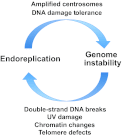Endoreplication and polyploidy: insights into development and disease
- PMID: 23222436
- PMCID: PMC3513989
- DOI: 10.1242/dev.080531
Endoreplication and polyploidy: insights into development and disease
Abstract
Polyploid cells have genomes that contain multiples of the typical diploid chromosome number and are found in many different organisms. Studies in a variety of animal and plant developmental systems have revealed evolutionarily conserved mechanisms that control the generation of polyploidy and have recently begun to provide clues to its physiological function. These studies demonstrate that cellular polyploidy plays important roles during normal development and also contributes to human disease, particularly cancer.
Figures





References
-
- Belyaeva E. S., Zhimulev I. F., Volkova E. I., Alekseyenko A. A., Moshkin Y. M., Koryakov D. E. (1998). Su(UR)ES: a gene suppressing DNA underreplication in intercalary and pericentric heterochromatin of Drosophila melanogaster polytene chromosomes. Proc. Natl. Acad. Sci. USA 95, 7532–7537 - PMC - PubMed
Publication types
MeSH terms
Grants and funding
LinkOut - more resources
Full Text Sources

